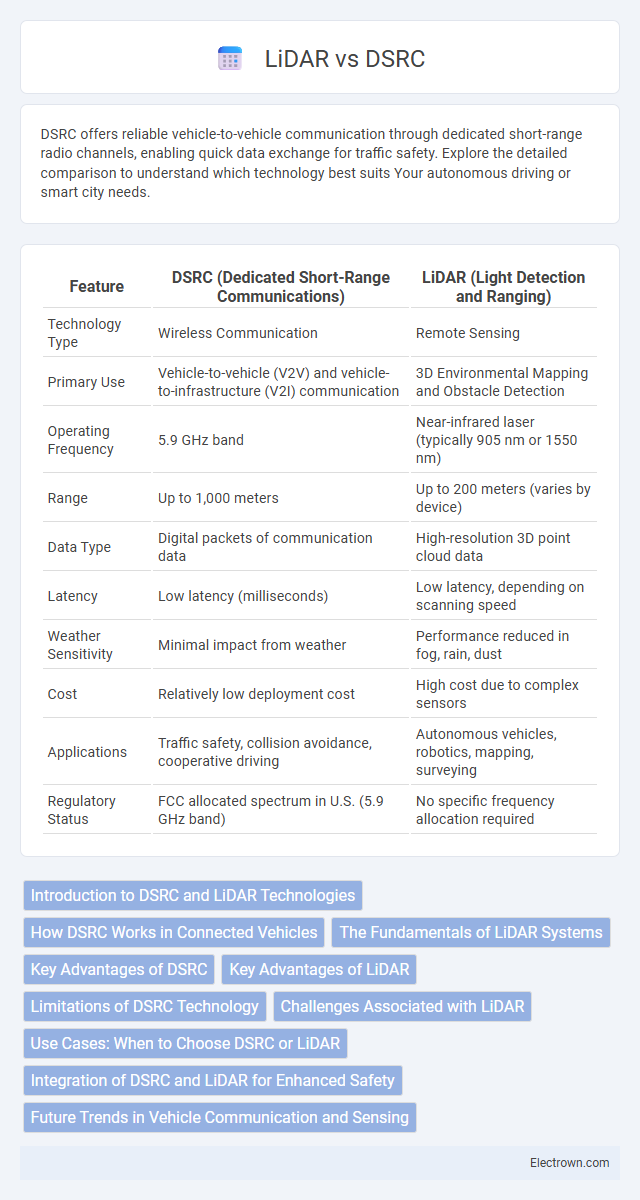DSRC offers reliable vehicle-to-vehicle communication through dedicated short-range radio channels, enabling quick data exchange for traffic safety. Explore the detailed comparison to understand which technology best suits Your autonomous driving or smart city needs.
Table of Comparison
| Feature | DSRC (Dedicated Short-Range Communications) | LiDAR (Light Detection and Ranging) |
|---|---|---|
| Technology Type | Wireless Communication | Remote Sensing |
| Primary Use | Vehicle-to-vehicle (V2V) and vehicle-to-infrastructure (V2I) communication | 3D Environmental Mapping and Obstacle Detection |
| Operating Frequency | 5.9 GHz band | Near-infrared laser (typically 905 nm or 1550 nm) |
| Range | Up to 1,000 meters | Up to 200 meters (varies by device) |
| Data Type | Digital packets of communication data | High-resolution 3D point cloud data |
| Latency | Low latency (milliseconds) | Low latency, depending on scanning speed |
| Weather Sensitivity | Minimal impact from weather | Performance reduced in fog, rain, dust |
| Cost | Relatively low deployment cost | High cost due to complex sensors |
| Applications | Traffic safety, collision avoidance, cooperative driving | Autonomous vehicles, robotics, mapping, surveying |
| Regulatory Status | FCC allocated spectrum in U.S. (5.9 GHz band) | No specific frequency allocation required |
Introduction to DSRC and LiDAR Technologies
DSRC (Dedicated Short-Range Communications) enables vehicle-to-vehicle and vehicle-to-infrastructure communication through low-latency wireless signals, enhancing traffic safety and efficiency. LiDAR (Light Detection and Ranging) uses laser pulses to create precise 3D maps of surroundings, crucial for advanced driver-assistance systems and autonomous vehicles. Understanding both technologies helps you evaluate their distinct roles in improving vehicle communication and environmental sensing.
How DSRC Works in Connected Vehicles
DSRC (Dedicated Short-Range Communications) operates using a wireless protocol specifically designed for fast, reliable vehicle-to-vehicle (V2V) and vehicle-to-infrastructure (V2I) communication within a limited range of about 300 meters. It transmits low-latency messages that enable real-time exchange of safety-critical information such as speed, position, and trajectory between connected vehicles and roadside units. Your vehicle leverages DSRC to anticipate potential collisions, optimize traffic flow, and enhance overall situational awareness without relying on line-of-sight like LiDAR technology does.
The Fundamentals of LiDAR Systems
LiDAR systems operate by emitting laser pulses and measuring the time it takes for the reflected pulses to return, enabling precise 3D mapping and object detection. These systems leverage high-frequency light waves to generate detailed spatial data, crucial for autonomous vehicles and advanced navigation applications. Unlike DSRC, which relies on radio signals for communication, LiDAR provides high-resolution environmental perception through active sensing technology.
Key Advantages of DSRC
DSRC (Dedicated Short-Range Communications) offers key advantages such as low latency communication crucial for real-time vehicle-to-vehicle (V2V) and vehicle-to-infrastructure (V2I) data exchange, enhancing traffic safety and efficiency. Its standardized protocol supports reliable, secure wireless communication over distances of approximately 300 meters, facilitating immediate hazard warnings and cooperative driving maneuvers. Your smart transportation system benefits from DSRC's proven interoperability and cost-effective deployment compared to LiDAR's higher integration complexity and expense.
Key Advantages of LiDAR
LiDAR technology offers unparalleled accuracy in 3D mapping and object detection, delivering high-resolution spatial data essential for safe autonomous vehicle navigation. Its capability to perform well in various lighting conditions, including complete darkness, outperforms the limitations of DSRC, which relies on signal communication and may face interference issues. Furthermore, LiDAR's real-time environment scanning enhances obstacle avoidance and traffic management, making it a critical component in advanced driver-assistance systems (ADAS).
Limitations of DSRC Technology
DSRC technology faces limitations such as limited data transmission range typically around 1,000 meters and susceptibility to interference from physical obstacles and weather conditions, which can diminish communication reliability. Its relatively low data bandwidth restricts the complexity and volume of information exchanged between vehicles. Your vehicle's safety and autonomy might be compromised in environments where DSRC signal quality is insufficient, highlighting the need for complementary technologies like LiDAR.
Challenges Associated with LiDAR
LiDAR faces challenges such as high costs, sensitivity to weather conditions like fog or heavy rain, and limited range compared to other sensing technologies. Its reliance on laser pulses can be obstructed by environmental factors, reducing accuracy and reliability in complex driving scenarios. Integration difficulties with existing vehicle systems and data processing demands further complicate widespread LiDAR adoption.
Use Cases: When to Choose DSRC or LiDAR
DSRC excels in vehicle-to-vehicle and vehicle-to-infrastructure communication for real-time traffic management and safety applications, making it ideal for urban environments with high connectivity demands. LiDAR is preferred for precise 3D mapping and object detection in autonomous driving, enabling accurate navigation and obstacle avoidance in complex or dynamic surroundings. Your choice depends on whether communication latency or spatial perception is the priority for your specific use case.
Integration of DSRC and LiDAR for Enhanced Safety
Integrating DSRC (Dedicated Short-Range Communications) and LiDAR (Light Detection and Ranging) enhances vehicular safety by combining real-time vehicle-to-vehicle communication with precise environmental sensing. DSRC provides low-latency data exchange for immediate hazard warnings, while LiDAR offers high-resolution 3D mapping to detect obstacles and road conditions. This fusion enables comprehensive situational awareness, improving collision avoidance and autonomous driving capabilities.
Future Trends in Vehicle Communication and Sensing
DSRC and LiDAR technologies are evolving to play complementary roles in future vehicle communication and sensing, enhancing safety and autonomous driving. DSRC provides reliable low-latency vehicle-to-vehicle (V2V) and vehicle-to-infrastructure (V2I) communication, critical for real-time traffic data exchange and collision avoidance. LiDAR offers high-resolution 3D environmental mapping essential for precise object detection and navigation, with advancements in solid-state LiDAR reducing cost and size for widespread automotive integration.
DSRC vs LiDAR Infographic

 electrown.com
electrown.com